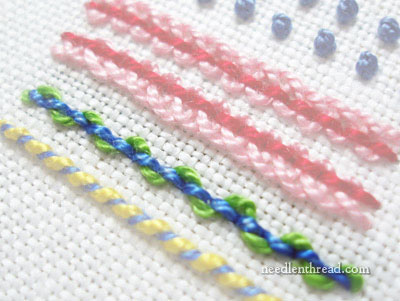The laced backstitch used in hand embroidery is somewhat like the whipped backstitch. To create the laced backstitch, the needle passes under a line of previously stitched backstitches, but instead of always passing under the stitches in the same direction, the laced backstitch passes under in alternate directions from stitch to stitch. To put it really simply, the needle goes up under one stitch and down under the next.

You can see a short line of laced backstitch in the photo above, in blue and green thread. The backstitch foundation is worked in the blue thread, and the green thread is laced behind the backstitches in a serpentine manner.
You can alter the look of the laced backstitch by playing around with it a bit. You can alter the tension on the lacing thread, so that the lacing is “hugging” the backstitch, or you can stop short of pulling the thread all the way through, to form “bumps” in the lacing that stand away from the backstitch line (as you can see in the video below). You can also lace the line in one direction and them come back and lace it again in the other, to completely surround the backstitches with your lacing thread.
How can you use the laced backstitch in hand embroidery? It works well as thick stems in crewel work. Imagine a line of dark green wool for the backstitch, with light green wool for the lacing, laced in both directions and pulled tight against the backstitch. This would create a two-toned line that has a bit of width and texture to it.
The laced backstitch can also be effectively used in seam treatments in crazy quilting, as well as for borders or bands on samplers. You can incorporate the laced backstitch in your surface embroidery as a variation on any line stitches.
In the video, I’m working with perle cotton #5 on linen. You’re not restricted to even-weave linen for backstitch and its variations. It can be worked just as well on plain weave (non-counted linen). Also, it’s helpful to use a tapestry needle with the lacing part of this stitch, because the blunt point of the tapestry needle won’t snag your backstitches.
Here’s the video for the laced backstitch. I hope you find some fun uses for it!
Do you want more inspiration & information on hand embroidery?
There are all kinds of reasons to sign up for the Needle ‘n Thread daily newsletter! Check them out and sign up today!
If you’re looking for more stitch instruction and inspiration, feel free to check out the collection of Hand Embroidery How-To Videos here on Needle ‘n Thread!
If you like what you see on Needle ’n Thread, if you want to be a part of keeping the website thriving (and free of annoying network advertising), why not become a patron on Patreon? Check out my Patreon page here, where I’ll occasionally add special needlework bonuses for patrons.
If you shop on Amazon, you can support Needle ’n Thread without any extra expense to you by visiting my Amazon Recommendations page here, where you’ll find books and sundries for the needleworker available on Amazon.







Bonjour,
Merci beaucoup.
bonne journée
Thanks for another great video Mary! Keep them coming….Thanks to you, I’ve learned hand embroidery.
Thank you, Mary. So pretty… These ‘simple’ things you teach us here look magical 🙂 and inspire.
Thank you all your videos, they are fantastic. I am going to monogram some bedding for a friends wedding, fingers crossed!!!!
Hi, I’m VERY new to embroidery and finding your videos so helpful. I was wondering in these videos, typically how many stands of the embroidery floss are you working with? Do you have a basic, knotting, tying off method? Sorry these are such basic questions!
Hi, Janaye – in the videos, I usually use a heavy embroidery thread called pearl cotton (usually size 5). This is a non-stranded thread, meaning you can’t take it apart. You use it as one fat strand right off the skein. I use it for the tutorials, because it’s easier to see in the videos and in photos. You can pretty much use any kind of thread with most stitches, but some stitches look better in thread that’s a little bulky. So, if you’re working with regular DMC embroidery floss, some of the stitches are more pronounced if you use two or three strands out of the six. You might look at this list of embroidery tips especially for beginners. You’ll find a link in there to a list of photo tutorials on starting and ending your embroidery threads. Hope that helps!
me llama la atención el tipo de bordado me gustaría aprender un poco más
Thanks to you I have very interesting hand mead sweeter by needle & crotch dress & slipper hand embroidery different things i live Africa in Ethiopia no yarn very problem help. Thanks
Hi Mary
Have you ever heard of the Mongolian stitch? Also known as ‘needle round stitch ‘? It works up a bit like a interlaced loopy backstitch but performed with two threads at a time.